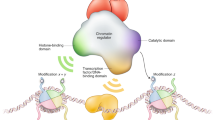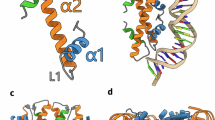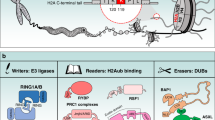Abstract
In addition to DNA sequence information, site-specific histone modifications are another important determinant of gene expression in a eukaryotic organism. We selected four modification sites in common histones that are known to significantly impact chromatin function and generated monoclonal or polyclonal antibodies that recognize each of those site-specific modifications. We used these antibodies to demonstrate that the site-specific histone modification levels remain relatively constant in different organs of the same organism. We also compared the levels of selected histone modifications among several representative organisms and found that site-specific modifications are highly variable among different organisms, providing new insight into the evolutionary divergence of specific histone modifications.
Similar content being viewed by others
Log in or create a free account to read this content
Gain free access to this article, as well as selected content from this journal and more on nature.com
or
References
Jenuwein T, Allis CD . Translating the histone code. Science 2001; 293:1074–1079.
Jasencakova Z, Soppe WJJ, Meister A, et al. Histone modifications in Arabidopsis-high methylation of H3 lysine 9 is dispensable for constitutive heterochromatin. Plant J 2003; 33:471–480.
Strahl BD, Allis CD . The language of covalent histone modifications. Nature 2000; 403:41–45.
Turner BM, Fellows G . Specific antibodies reveal ordered and cell-cycle-related use of histone-H4 acetylation sites in mammalian cells. Eur J Biochem 1989; 179:131–139.
Turner BM, Laura PO, Allan IM . Histone H4 acetylation in human cells frequency of acetylation at different sites defined by immunolabeling with site-specific antibodies. FEBS Lett 1989; 253:141–145.
Suka N, Suka Y, Carmen AA, Wu J, Grunstein M . Highly specific antibodies determine hisotne acetylation site usage in yeast heterochromatin and euchromatin. Mol Cell 2001; 8:473–479
Polet HS, Sethupathi P, Yam P-C, Knight KL . Rabbit monoclonal antibodies: generating a fusion partner to produce rabbit-rabbit hybridomas. Proc Nat Acad Sci. USA 1995; 92:9348–9352
Allfrey VG, Faulkner R, Mirsky AE . Acetylation and methylation of histones and their possible role in the regulation of RNA synthesis. Proc Nat Acad Sci USA 1964; 51:789–794
Loidl P . A plant dialect of the histone language. Trends Plant Sci 2004; 9:84–90
Couppez M, Annie MP, Sautiere P . Histone H4 from Cuttlefish Testis is sequentially acetylated. J Biol Chem 1987; 262:2854–2860
Jackson JP, Johnson L, Jasencakova Z, et al. Dimethylation of histone H3 lysine 9 is a critical mark for DNA methylation and gene silencing in Arabidopsis thaliana. Chromosoma 2004; 112:308–315
Ringrose L, Ehret H, Paro R . Distinct Contributions of Histone H3 Lysine 9 and 27 Methylation to Locus-Specific Stability of Polycomb Complexes. Mol Cell 2004; 16:641–653.
Bastow R, Mylne JS, Lister C, et al. Vernalization requires epigenetic silencing of FLC by hisotne methylation. Nature 2004; 427:164–167.
Briggs SD, Bryk M, Strahl BD, et al. Histone H3 lysine 4 methylation is mediated by Set1 and required for cell growth and rDNA silencing in Saccharomyces cerevisiae. Genes Dev 2001; 15:3286–295.
Gendrel AV, Lippman Z, Martienssen R, Colot V . Profiling histone modification patterns in plants using genomic tiling microarrays. Nat Methods 2005; 2:213–218
Strahl BD, Ohba R, Cook RG, Allis CD . Methylation of hisotne H3 at lysine 4 is highly conserved and correlates with transcriptionally active nuclei in Tetrahymena. Proc Nat. Acad Sci USA 1999; 96:14967–14972
Rice JC, Briggs SD, Ueberheide B, et al. Histone methyltransferases direct different degrees of methylation to define distinct chromatin domains. Mol Cell 2003; 12:1591–1598.
Peters AH, Kubicek S, Mechtler K, et al. Partitioning and plasticity of repressive histone methylation states in mammalian chromatin. Mol Cell 2003; 12:1577–1589.
Nagaki K, Cheng Z, Ouyang S, et al. Sequencing of a rice centromere uncovers active genes. Nat Genet 2004; 36:138–145.
Waterborg JH . Dynamics of histone acetylation in Saccharomyces cerevisiae. Biochemistry 2001; 40:2599–2605.
Chua YL, Brown APC, Gray JC . Targeted histone acetylation and altered nuclease accessibility over short regions of the pea plastocyanin gene. Plant Cell 2001; 13:599–612.
Chua YL, Watson LA, Gray JC . The transcriptional enhancer of the pea plastocyanin gene associates with the nuclear matrix and regulates gene expression through histone acetylation. Plant Cell 2003; 15:1468–1479.
Acknowledgements
We thank Shunong Bai for providing Calf histone protein sample, Yuling Jiao, Ligeng Ma, and Jiwan Qiu for helpful discussion and suggestions in antibody production, Ning Cai, Ting Fu, and Taotao Lao of the Chinese Division of Epitomics Biotech Co. Ltd. for production of monoclonal antibodies, and Valerie J Karplus for critical reading of this manuscript. This research was funded by the Hi-Tech Research and Development Program of China (Grant 2003-AA210070).
Author information
Authors and Affiliations
Corresponding author
Rights and permissions
About this article
Cite this article
Guo, L., Yin, B., Zhou, J. et al. Development of rabbit monoclonal and polyclonal antibodies for detection of site-specific histone modifications and their application in analyzing overall modification levels. Cell Res 16, 519–527 (2006). https://doi.org/10.1038/sj.cr.7310063
Received:
Revised:
Accepted:
Published:
Issue date:
DOI: https://doi.org/10.1038/sj.cr.7310063



